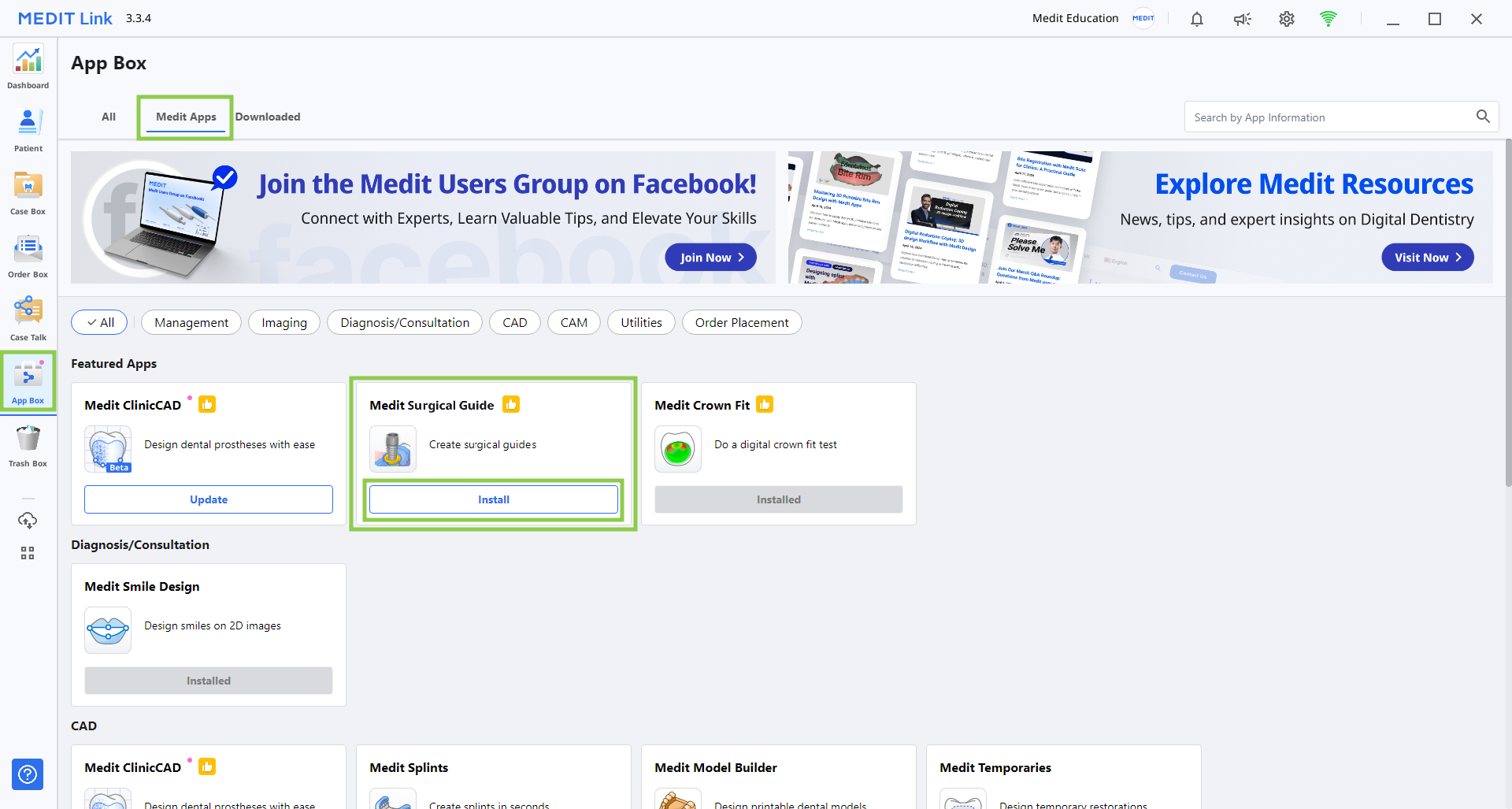Overview
Medit Surgical Guide is a CAD program designed to streamline and optimize the in-office workflow for planning implant surgeries and designing 3D-printable surgical guides. The software operates as a semi-automated solution, where key steps—such as integrating the patient's CBCT and digital impression data, aligning anatomical structures, tracing nerves, and positioning implant elements—are partially automated to reduce manual efforts. Still, professional oversight is integral at each stage, allowing dentists to review and adjust the results to ensure precision and tailor the final guide's design to each case.
By combining automation with expert supervision, Medit Surgical Guide empowers dentists to deliver accurate, efficient, and personalized treatment solutions.
Intended Use
Medit Surgical Guide is a software designed to assist trained dental professionals in creating virtual plans before implant surgery and designing surgical guides using intraoral scan data and CBCT data. It enables users to perform tasks such as aligning CBCT and scan data, analyzing CBCT data, planning for implants, and creating guides and reports.
A trained dental professional must review the created surgical plan and guide. Be advised that misuse of the software can severely impact the patient's oral health, and the user assumes full responsibility for the outcomes.
The program must not be used for purposes other than those described in its intended use.
Indications for Use
Medit Surgical Guide is designed to assist with virtual planning for implant surgery and the creation of surgical guides.
Usage Restrictions
The program may show reduced performance of AI for Automatic Detection and Segmentation of Inferior Alveolar Nerve on images that do not meet the data selection criteria (e.g. individuals under 18 years of age, severely reduced image quality, or unclear visualization of the neural canal).
Caution and Disclaimer
The AI model may show reduced prediction performance or present inaccurate results (such as hallucinations) when encountering unstructured data not included in its training set, rare anatomical structures, or imaging containing unexpected noise.
The automatic segmentation results provided by AI for Automatic Detection and Segmentation of the Inferior Alveolar Nerve are intended to support the judgement of professionals with formal medical training and clinical experience.
Final decisions regarding diagnosis and treatment must always be made by a qualified medical professional.
Suggestions made by the AI should always be critically reviewed in conjunction with clinical knowledge and other relevant information.
Contraindications
The software cannot be used for purposes other than creating surgical guides.
Intended User Profile
The software is designed for dental professionals who have a basic understanding of dental procedures and terminology to operate it effectively and interpret its outputs. This includes but is not limited to dentists, dental hygienists, and dental technicians.
Intended Patient Profile
The software can be used for patients who have lost teeth or require implant prosthetic treatment.
Patient Safety Advisory
If the surgical guide design is incorrect, it can adversely affect the patient's oral health, potentially damaging the inferior alveolar nerve or perforating the maxillary sinus.
However, all decisions the doctor makes based on the program outputs require understanding how the software operates and interprets data. Thus, while the software can assist in treatment planning, an experienced clinician must make the final decision. At each stage of the surgical guide's design process, there are ample opportunities to identify and rectify any inaccuracies or errors and prevent them from causing injuries. The dental professional must closely monitor the design and decision-making processes.
Security Risk Management and Error Handling
After the issue has been improved, if it is necessary to update the program, such as releasing a new installation file or applying some patch files, it is officially distributed through the head office sales/SE personnel along with the application guide to the person in charge of the corporation or the issue site.
Responses to security issues may be further announced on the website if necessary.
Reporting security issues
Share initial analysis results and progress
Issue delivery
Issue response plan / delivery
Issue response plan / share results
System Requirements
Windows
CPU | Intel Core i5 2.6 GHz or higher |
RAM | 16 GB or higher |
Graphics Card | NVIDIA GeForce GTX 1060 (2 GB) or higher |
OS | Windows 10 64-bit, Windows 11 64-bit |
macOS
CPU | 8-core or higher |
RAM | 16 GB or higher |
Chip | M1/M2 or higher |
OS | Monterey 12 |
Installation Guide
1. Log into your Medit Link account and go to the App Box on the left-hand menu.
2. In the Medit Apps tab, find the Medit Surgical Guide app and click "Install."

3. Read the Software License Agreement and confirm app installation by clicking "Accept and Install."
.png)
4. The app will be downloaded and installed automatically. It may take several minutes to finish the installation process.
⚠️Caution
Do not turn off the PC or close Medit Link during the installation process.
5. Once the app is installed, you can run it from any case in Medit Link by clicking the app icon in the right corner of the Case Detail window.

🔎Note
The program can only be used if the form information was provided in the Medit Link case. Remember to register target teeth in the form and assign them as a 'surgical guide' before running the app.